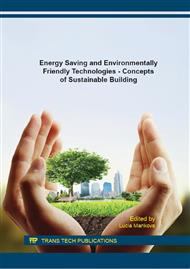p.259
p.267
p.278
p.288
p.299
p.307
p.315
p.323
p.331
The Use of a Mathematical Model for the Management and Distribution of Heat
Abstract:
The following article describes the designed and implemented mathematical model of the distribution model of heat consumption in an urban agglomeration. The model is intended for the prediction of heat supply, which can be applied in the regulation system. Depending on the structure of a given real-life system it is usually required for the heating water temperature to be predicted.For the purposes of describing the heat consumption characteristics a function characterizing the heat consumption fluctuation has been established. The fluctuation is defined by number of variables such as outdoor temperatures, solar radiation etc.
Info:
Periodical:
Pages:
299-306
Citation:
Online since:
January 2016
Authors:
Price:
Сopyright:
© 2016 Trans Tech Publications Ltd. All Rights Reserved
Share:
Citation:


